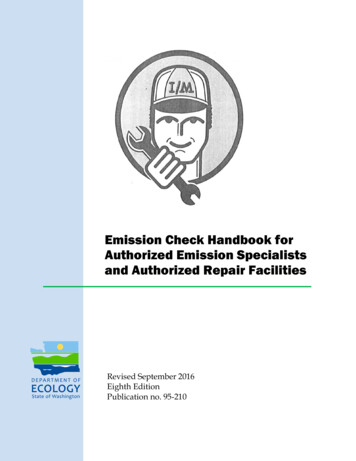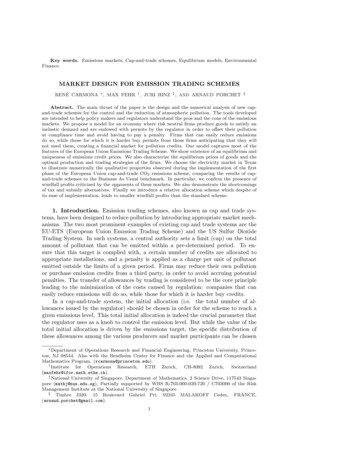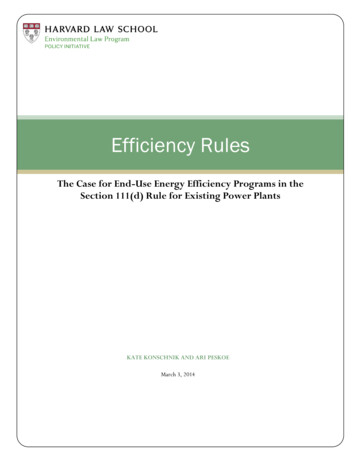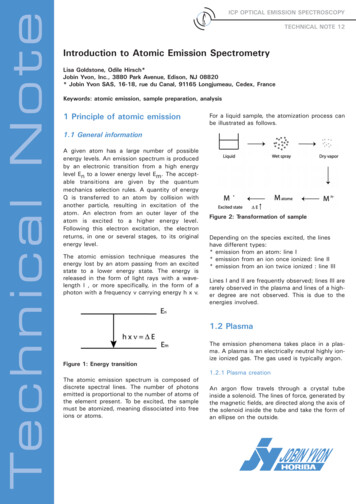
Transcription
Emission Check Handbook forAuthorized Emission Specialistsand Authorized Repair FacilitiesRevised September 2016Eighth EditionPublication no. 95-210Template
Publication and Contact InformationThis report is available on the Department of Ecology’s website Pages/95210.htmlFor more information contact:Air Quality ProgramP.O. Box 47600Olympia, WA 98504-7600Phone: (360) 407-6800Washington State Department of Ecology - www.ecy.wa.govo Headquarters, Olympia(360) 407-6000o Northwest Regional Office, Bellevue(425) 649-7000o Southwest Regional Office, Olympia(360) 407-6300o Central Regional Office, Yakima(509) 575-2490o Eastern Regional Office, Spokane(509 0 329-3400To request ADA accommodation, call (360) 407-6800, 711 (relay service), or (877) 833-6341 (TTY).
Emission Check Handbook for AuthorizedEmission Specialists and AuthorizedRepair FacilitiesbyEmission Check Field Services StaffAir Quality ProgramWashington State Department of EcologyOlympia, Washington
This page is purposely left blank
Table of ContentsPageList of Figures and Tables.vFigures.vTables .vAcknowledgments. viiIntroduction .9The Emission Check Program .9You make cars run cleaner .9We help each other.9Save and use this handbook .10Chapter 1: The Basics .11What is Washington State’s Emission Check Program? .11Air Pollution .12Gasoline engine emission controls .14Chapter 2: General Requirements .17Authorized emission specialists .17Authorized emission check repair facilities .18Authorized test facilities (ATF) .22Chapter 3: Certificate of Acceptance (repair waiver) .23Overview .23Warranty rules and policies .24Federal warranty laws.24Chapter 4: Tampering .29Overview .29Forms of tampering .29Chapter 5: Repair Shop Equipment Standards and Procedures .33Gasoline equipment, emission standards, and procedures .33Gasoline emissions tail pipe test procedures .33OBDII test procedure .34Diesel equipment, emission standards and procedures .35Snap-Idle procedure.35Chapter 6: Test Facility Equipment and Calibration .37Chapter 7: Vehicle Change of Registration .39Chapter 8: Tips for your customers .41Chapter 9: Technician Tips .45Understand the conditions under which the vehicle failed .45Recalls, pattern failures, and preconditioning.45Diagnose the problem .46Correct the problem .51Emission Check Handbook for Authorized Emission Specialists and Authorized Repair Facilitiesiii
Chapter 10: On Board Diagnosis (OBDII) .55A short history of OBDII .55What is the MIL? .55Is OBDII the answer? .56The primary goal of OBDII is to prevent catalytic converter failures.56Will an OBDII not ready fail the test? Yes .56Diagnose the problem .57DLC and location .58Correct the problem/Effective repairs. .60Certificate of Acceptance (Waiver) .63Appendix A: Glossary / Index .65Appendix B: Chapter 70.120 RCW Motor Vehicle Emission Control .71Appendix C: Chapter 173-421 WAC Motor Vehicle Emission Control Systems .79Appendix D: Chapter 173-422A WAC Motor Vehicle Emission Inspection.81Appendix E: Applus Test Station Locations .91Appendix F: Resources for AES shops .93Appendix G: Emission Check Posters .95Appendix H: Air/Fuel Information .97Exhaust gas relationship chart .97Appendix I: Common Causes of High Emission Readings .99Appendix J: Customer Waiver Checklist .101Appendix K: OBDII Diagnostic Powertrain Codes .103Appendix L: Examples of CARB EO Stickers .105Emission Check Handbook for Authorized Emission Specialists and Authorized Repair Facilitiesiv
List of Figures and TablesPageFiguresFigure 1. Ringlemann / Smoke Chart . 36Figure 2. DTC Structure . 57Figure 3. OBD-II Connector and Pinout . 59Figure G-1. Authorized Repair Facility Poster (ECY 12-02-006). 95Figure G-2. Emission Check Waiver Poster . 95Figure H–1. Emissions Curves . 97Figure N-1. Examples of CARB EO Stickers . 105TablesTable 1. Two Speed Idle Test Exhaust Emission Standards . 33Table 2. Washington’s Diesel Engine Standards . 35Table D-1. Testing Schedule for Private and United States Government Vehicles . 82Table D-2. Testing Schedule for State and Local Government Vehicles . 82Table D-3. Emission Test Areas . 83Table D-4. Two-speed Idle Exhaust Emission Test Standards . 84Table D-5. Exhaust Emission Test Standards for Diesel Vehicles . 85Emission Check Handbook for Authorized Emission Specialists and Authorized Repair Facilitiesv
This page purposely left blankEmission Check Handbook for Authorized Emission Specialists and Authorized Repair Facilitiesvi
AcknowledgmentsThis handbook is a product of the Washington State Department of Ecology Emission CheckField Services staff:Contributing Writers .Fritz Merkl, Arthur Betts, Rachael O’Malley, Dave Pavlin, MattiasBrischle, David Adler, Mathew Kwartin, Kerry Swayne, John Dillon, and Barbara FreemanTraining team . Mathew Kwartin, Art Betts, Rachael O’Malley, and Mattias BrischleEditing .Kerry SwayneReview . Nick Roach, Melanie Forster, John Raymond, and Sarah ElledgeTechnical Reviewers . Howard Anderson, Ed Schaplow, and Fred WilsonFirst Edition . August 1995First Revision . January 1996Second Edition . September 1998Third Edition . February 2004Fourth Edition . March 2008Fifth Edition . January 2010Sixth Edition . January 2012Revised Sixth Edition . January 2013Seventh Edition . January 2015Eighth Edition . September 2016Emission Check Handbook for Authorized Emission Specialists and Authorized Repair Facilitiesvii
This page is purposely left blankEmission Check Handbook for Authorized Emission Specialists and Authorized Repair Facilitiesviii
IntroductionThe Emission Check ProgramThank you for participating in the Emission Check Program. This program is comprised of twocomponents, Inspection and Maintenance, referred to as I/M. Most motorists see only theinspection side, the test facility. However, thanks to maintenance and repair work performed bythe automotive service industry, vehicle emissions are being lowered.You make cars run cleanerHow important is the industry’s participation? According to the Department of Ecology’sreview of Emission Check Program records, repaired vehicles showed average emissionreductions of 73% for carbon monoxide and 75% for hydrocarbons.Waived vehicles showed average emission reductions of 37% for carbon monoxide and 14% forhydrocarbons.Results like these make it clear that appropriate repairs directed at reducing emissions make amajor difference in the air we breathe. The repairs to the dirtiest vehicles make the entire groupof vehicles in the Emission Check area more than 20% cleaner. This helps keep the air healthierfor everyone.Asthma attacks can come from air pollution. Research has shown that children and seniors aremore susceptible to breathing challenges due to air pollution. In addition, since children breathetwice as often and twice as much air as adults, we want to reduce air pollution as much aspossible for their young lungs.We help each otherYour participation in the Emission Check Program is 100% voluntary. There are rules to ensureeffective repairs and maintain consumer confidence. Ecology authorizes both the emissionspecialists and the vehicle repair facilities.Ecology provides the following for shops and technicians in the Emission Check Program: A list of Emission Check shops available online at www.emissiontestwa.com. Statewide,over 100,000 vehicles are referred annually to the authorized shops. Technical support available through your local field office. When in doubt about a part,procedure, or problem, do not guess, call. The toll free number is 1-800-272-3780 or 509329-3491 if calling from Spokane.Emission Check Handbook for Authorized Emission Specialists and Authorized Repair Facilities9
Save and use this handbookThere are three areas of information covered in this manual: Emission Check rules and policies that apply to participating automotive repair businesses.Practical information and tips from Ecology’s Emission Check field staff.General information, which includes maps, charts, agency forms, and internet links.This handbook describes how the Emission Check Program works and how it is supervised.The laws that authorize the Emission Check Program are included in the Revised Code ofWashington (RCW): Chapter 70.120A Motor Vehicle Emission Standards.The regulations are included in the Washington Administration Code (WAC):Chapters 173-421 Emission Controls, Inspections, and 173-422A Motor Vehicle EmissionInspection.This handbook does not replace technical training or experience. Your skills and background areimportant. They help keep Washington a healthier place to breathe.Emission Check Handbook for Authorized Emission Specialists and Authorized Repair Facilities10
Chapter 1: The BasicsWhat is Washington State’s Emission Check Program?Our program helps identify grossly polluting vehicles. It is part of the same national strategythat requires automobile manufacturers to build vehicles with pollution controls. I/M programslike Emission Check help make sure that each vehicle’s emission control system is doing its job.Parts of the country that have had air pollution problems use I/M programs to attain or maintaingood air quality.History: The Emission Check Program began in Seattle and surrounding areas in 1982 with anidle only test. At this time, the test was designed to pinpoint gross polluters and the limits wereset quite high at 6.0% Carbon Monoxide (CO) and 1000 ppm Hydrocarbons (HC). Spokane andsurrounding areas began testing in 1985. During 1990, two-speed testing began so both cruiseand idle emissions could be tested. The emission standards were lowered over time and includedmultiple ranges to cover the various years of vehicles on the road. In 1993, responding tochanges in the federal Clean Air Act, Ecology expanded the program to include the Vancouverarea, and more of the Spokane and the Puget Sound regions. Diesel vehicles also began to betested. Most vehicles were tested on a dynamometer to replicate on road conditions. Changes in2002 kept pace with technology and the needs of the environment by adding an On BoardDiagnostics II (OBDII) Diagnostic Trouble Codes (DTCs) check. The computer instead of thetail pipe now tested model years 1996 and newer gasoline cars, and light duty trucks. Withtechnology advances, the test program was changed once more in 2012. Fewer vehicles aretested due to new car standards and administrative moves to simplify the testing process. Asignificant change was the move toward being a “Hybrid” program. Meaning that Emissiontesting may also be performed at retail establishments as well as the test stations. These retailtest stations are called Authorized Test Facilities (ATFs)Gasoline vehicle inspection: The program tests for DTC on OBDII compliant vehicles and HCand CO emissions are tested at the tail pipe on older and heavy-duty vehicles.Diesel vehicle inspection: The program tests for the opacity or smoke density of the exhaustplume. The standard SAE J-1667 snap method is used. This incorporates a series of throttlesnaps to clear and then sample the exhaust plume.Vehicles affected in an emissions check area: Unless otherwise exempted, vehicles less than26 years, gasoline vehicles older than model year 2009, and diesel vehicles older than model2007 are tested. Vehicles determined by the Environmental Protection Agency (EPA) to exceed50 mpg are exempt. These are the Toyota Prius and Honda Insight. Vehicles registered as beingsolely powered by Compressed Natural Gas (CNG), Liquid Petroleum Gas (LPG), or electricityare exempt. Diesel vehicles with a scale weight of less than 6000 lbs are also exempt. The test isdetermined by model year. The test cycle for 1995 and older vehicles is even year vehicles test ineven years and odd year vehicles in odd years. The test cycle for 1996 and newer vehicles is oddyear vehicles test in the even years and even year vehicles test on the odd years.A passing Emission Check certificate is valid for twelve (12) months.Emission Check Handbook for Authorized Emission Specialists and Authorized Repair Facilities11
Fees at an Applus test station: Fees are 15 cash (No Canadian funds), check (traveler’s checksmaximum 50) or credit card (Master Card, Visa, Discover). The fee includes one free retestafter the initial failure, but after that, each additional inspection is 15.Fees at an ATF: Fees are set by the ATF’s price schedule and may vary from shop to shop.Vehicles that fail the emission test will NOT receive a free re-test at an Applus test station or anATF.Vehicles that fail: Over 90% of all tested vehicles in Washington pass the first inspection. Ifthe vehicle fails, the driver receives a list of Ecology authorized repair shops. Most vehicles,nearly 50,000, pass the first retest and another 8,000 pass the second retest, after receivingappropriate repairs or diagnostics. Emission Check’s goal is to reduce emissions. There is norestriction on who performs repair work, as long as the vehicle passes a retest. However, to beeligible for the waiver program, an Authorized Emission Specialist must perform repairs at anauthorized repair shop.Waivers: A vehicle owner may obtain a waiver after attempting to have the vehicle repaired orproperly diagnosed. To be eligible for a waiver, these repairs and/or diagnostics must be madeby an AES at an authorized repair shop. The cost of parts, labor, supplies, and sales tax musttotal at least 150.00. The waiver process allows motorists to avoid costs that many cannotafford. Waivers are issued by test facility staff and, in certain cases, by Ecology. Less than threepercent of all vehicles inspected receive a waiver. The waiver is for the current test cycle. Thereis no limit to how often a customer may receive a waiver.Telephone help: Motorists are able to call Ecology’s Emission Check staff with questions orconcerns at the numbers listed by county.King, Snohomish, Pierce, and Clark, counties: 1 (800) 272-3780Spokane County (509) 329-3491Air PollutionWhat is air? Air contains about 78% nitrogen, 21% oxygen, and one percent other gases, pluswater vapor. The oxygen in the air keeps people and animals alive. The nitrogen is inert; it doesnot help and it does not hurt. Most of the other gases, but not all, are harmless, too.How much air does a person need? Each day you breathe about 35 pounds of air. That isabout 3,400 gallons a day or two gallons a minute. Compare that to your need for water; severalglasses a day. Without water, you can live a few days. Without air, you may last a few minutes,at most.What is air pollution? Air pollution, in one form or another, has always existed. In nature,pollution comes from volcanoes, dust storms, decaying vegetation, and even evergreen forests.People cannot control this kind of pollution. However, we can control the types of pollution wecause. Air pollution can affect our health at relatively low concentrations measured in parts permillion or billion, depending on the pollutant.Emission Check Handbook for Authorized Emission Specialists and Authorized Repair Facilities12
How much do automobiles pollute the air? Vehicles contribute a large share of the airpollution caused by humans. Vehicles contribute about half of both HC and Oxides of Nitrogen(NOx), as well as three quarters of the CO.How much air pollution is too much? Since even nature does not produce pure air, peoplecannot expect to eliminate all pollution. The federal government has set health standards for theoutdoor air. These standards set limits on how much of each of the major pollutants the air cancontain and still not cause health problems. Pollution control efforts aim to meet these healthstandards.How are automobile emissions controlled? Since 1968, the U.S. Government has requiredautomakers to control the amount of pollution in the exhaust. The carmakers redesigned parts ofthe engine and developed emission control systems. Today’s cars produce many times lesspollution than those built before the 1968 emission requirements.Why do only some places have emission inspections? Most air pollution occurs in and aroundlarge cities where most of the people and most motor vehicles are located. Based on air pollutionmonitoring, the U. S. Government has declared “nonattainment” areas in places that have hadtrouble keeping air pollution within the health standard. In these non-attainment areas, thefederal government requires states to monitor for and to improve air quality. Pollution frommotor vehicles contributes to the problem. If a non-attainment area succeeds in achieving goodair quality, it becomes a “maintenance area” and I/M programs often remain in place to helpkeep air pollution under control.What are the problem emissions from cars and trucks? In Washington, they are carbonmonoxide and hydrocarbons from gasoline vehicles, and fine particles from diesel vehicles. Carbon monoxide is produced in large quantities by the automobile. It is a result ofincomplete combustion of gasoline. It is a colorless, tasteless, and odorless gas. COdisplaces oxygen in the blood. The highest levels occur in cities where traffic isconcentrated. The most likely times for high CO levels are the calm, cold periods betweenstorms in the winter. Urban areas in Washington State seldom have CO problems anymore. Hydrocarbons are vapors of unburned gasoline. They can irritate the eyes and somehydrocarbons are known or suspected causes of cancer and other health problems. On sunny,hot days, they mix with other air pollution to form ozone (smog) at ground level. This is notthe same as the depletion of the ozone layer high in the atmosphere. Ozone irritates eyes andbreathing passages, and harms crops and forests. The most likely times for high ozone levelsare on sunny, calm hot summer days. Particulate matter (PM) are fine particles produced by diesel engines. The particles are toosmall to see with the naked eye except when concentrated as smoke. They can be presenteven when there is no obvious smoke. The particles are easily inhaled deep into the lungs.They can damage the delicate tissue that allows oxygen to pass from the air to the blood. Inaddition, toxic chemicals can “hitchhike” into the lungs on these particles. . Periods of calmwinter weather and during temperature inversions are the most likely times for high levels offine particles. “Burn Bans” are often called during these periods.Emission Check Handbook for Authorized Emission Specialists and Authorized Repair Facilities13
Gasoline engine emission controlsThe need to control the emissions from automobiles gave rise to the computerization of theautomobile. HC, CO and NOx are created during the combustion process and are emitted into theatmosphere from the tail pipe. There are also hydrocarbons emitted as a result of vaporization ofgasoline and from the crankcase of the automobile. The clean air act of 1977 set limits as to theamount of each of these pollutants that could be emitted from an automobile. The manufacturersanswer was the addition of certain pollution control devices and the creation of a self-adjustingengine. 1981 saw the first of these self-adjusting engines. They were called feedback fuel controlsystems. An oxygen sensor was installed in the exhaust system and would measure the fuelcontent of the exhaust stream. It then would send a signal to a microprocessor, which wouldanalyze the reading and operate a fuel mixture or air mixture device to create the proper air/fuelratio. As computer systems progressed, they were able to adjust ignition spark timing as well asoperate the other emission controls that were installed on the vehicle. The computer is alsocapable of monitoring and diagnosing itself. If a fault is seen, the computer will alert the vehicleoperator by illuminating a malfunction indicator lamp. The computer will at the same timerecord the fault in its memory, so that a technician can at a later date retrieve that fault in theform of a code, which will help them determine the proper repair. The following are some of themore typical emission control devices installed on an automobile.PCV valve: The purpose of the positive crankcase ventilation (PCV) system is to take thevapors produced in the crankcase during the normal combustion process, and redirecting theminto the air/fuel intake system to be burned during combustion. These vapors dilute the air/fuelmixture so they have to be carefully controlled and metered in order to not affect theperformance of the engine. This is the job of the positive crankcase ventilation (PCV) valve. Atidle, when the air/fuel mixture is very critical, just a little of the vapors are allowed in to theintake system. At high speed when the mixture is less critical and the pressures in the engine aregreater, more of the vapors are allowed in to the intake system. When the valve or the system isclogged, vapors will back up into the air filter housing or at worst the excess pressure will pushpast seals and create engine oil leaks. If the wrong valve is used or the system has air leaks, theengine will idle rough, or at worst, engine oil will be sucked out of the engine.Evaporative controls: Gasoline evaporates quite easily. In the past, these evaporative emissionswere vented into the atmosphere. 20% of all HC emissions from the automobile are from the gastank. In 1970 legislation was passed, prohibiting venting of gas tank fumes into the atmosphere.An evaporative control system was developed to eliminate this source of pollution. The functionof the fuel evaporative control system is to trap and store evaporative emissions from the gastank and carburetor. A charcoal canister is used to trap the fuel vapors. The fuel vapors adhere tothe charcoal, until the engine is started, and engine vacuum can be used to draw the vapors intothe engine, so that they can be burned along with the fuel/air mixture. This system requires theuse of a sealed gas tank filler cap. This cap is so important to the operation of the system, that atest of the cap is now being integrated into many state emission inspection programs. Pre-1970cars released fuel vapors into the atmosphere through the use of a vented gas cap. Today with theuse of sealed caps, redesigned gas tanks are used. The tank has to have the s
Washington (RCW): Chapter 70.120A Motor Vehicle Emission Standards. The regulations are included in the Washington Administration Code (WAC): Chapters 173-421 Emission Controls, Inspections, and 173-422A Motor Vehicle Emission Inspection. This handbook does not replace technical training or experience. Your skills and background are important.










